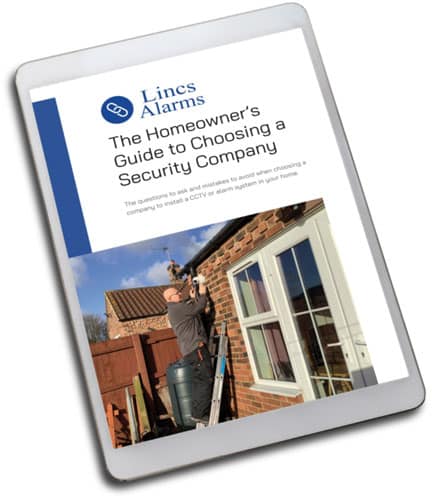CCTV Camera Placement: How to Get the Best Coverage Around Your Home
Investing in a home security system is one of the most effective ways to protect your property and loved ones. In the UK, closed-circuit television (CCTV) has become a staple of modern home security, providing deterrence against intruders and valuable evidence if a crime occurs. However, simply purchasing a high-end camera system isn’t enough.
If a camera is pointed at a brick wall or blinded by the morning sun, even the most expensive 4K technology becomes redundant. The effectiveness of your security system depends almost entirely on CCTV camera placement UK homeowners often overlook.
The correct positioning can make all the difference, as poor placement can lead to significant blind spots, legal issues with neighbours, and low-quality footage that fails to identify threats.
As a leading security installer, Lincs Alarms offers professional CCTV services for homeowners and businesses looking to better protect their properties. Over the years, we have come to understand the best position for CCTV cameras and what needs to be done for maximum coverage.
This guide will help you navigate the complexities of CCTV camera positioning. From identifying vulnerable entry points to understanding optimal mounting heights, we will explore the key factors for achieving the absolute best coverage for your home.
Why CCTV Camera Placement Matters
You might think that covering the front door is enough, but comprehensive security requires a more strategic approach. The primary goal of any CCTV system is crime prevention; to see what is happening clearly and, ideally, prevent it from happening in the first place.
When cameras are placed haphazardly, you risk creating coverage gaps. These are areas of your property that remain unmonitored, offering potential intruders a safe route in and out.
Effective CCTV camera placement creates overlapping fields of view, meaning that as a subject leaves the view of one camera, they enter the view of another. To ensure cameras provide continuous tracking of movement around the perimeter, proper placement is essential.
Furthermore, home CCTV coverage tips often emphasise the psychological aspect of security. Visible, well-placed cameras act as a strong deterrent. If a potential burglar spots a camera covering the driveway and another monitoring the side gate, they are significantly more likely to move on to an easier target.
CCTV Camera Placement Guide: Key Areas to Cover Around Your Home
To ensure your home is fully protected, you need to think like an intruder. Where are the weak points, and which areas are considered prime targets for break-ins? Here are the best places to place cameras to ensure maximum security.
Entrances and Exits
Statistics consistently show that a high percentage of burglars enter homes through the front or back door. Most burglars target these entry points because they are often less secure and provide quick access to the interior, as we explore in our blog post on How To Prevent Break-Ins In Lincolnshire
With this in mind, entry points should be your first priority when it comes to CCTV camera placement:
- Front Door: Position the camera at a height that captures the face of anyone approaching. If you have a porch, ensure the camera isn’t blocked by pillars or hanging plants. Monitoring the front door is crucial, as it is a common location for a break-in, with many intruders attempting to gain access through this main entrance. Statistics on break-ins indicate that a significant number occur at the front door.
- Back and Side Doors: These are often more secluded than the front, giving intruders more time to work on a lock and attempt to gain access without being seen. Ensure these cameras are visible to act as a deterrent and reduce the risk of a break-in.
- Garage Doors: Garages are common targets for theft of tools, bikes, and vehicles. A camera here should cover the full width of the driveway approach, as intruders may try to gain access through the garage during break-ins.
Driveways and Paths
Your driveway is often the first point of contact for anyone entering your property. Monitoring this area allows you to track vehicles and spot suspicious activity before someone reaches the house.
Capturing number plates at the driveway is important for identifying vehicles entering or leaving the property, which enhances security and helps in the identification of intruders.
When positioning cameras here, be mindful of the sun. If a camera faces directly East or West, sunrise or sunset glare might blind the lens at critical times of the day.
Perimeter and Garden
High fences and hedges can provide privacy, but they also offer cover for intruders. Outdoor CCTV camera placement should focus on the perimeter, specifically gates and low fences that are easy to climb. For cameras placed in the garden or on the perimeter, it is important to use protective casings to prevent tampering or damage.
If your garden is large, consider wide-angle cameras that can cover broad swathes of the lawn to prevent anyone from hiding in the shrubbery, and always take into account lighting conditions to ensure clear footage in both day and night.
Windows and Vulnerable Access Points
Ground-floor windows are notorious weak spots, especially those at the rear of the property or obscured by bushes. These areas are often targeted because they may contain valuable objects such as electronics or jewellery.
Side windows and conservatory doors also need attention, especially those that are hidden from street view or are less frequently used.
The aim here is to position cameras to capture both the act of tampering with a window and the face of the individual involved.
Technical Considerations for Optimal CCTV Camera Placement
Choosing the right location is only part of the battle; you also need to consider the technical limitations and capabilities of your hardware to optimise home security cameras.
Properly positioning CCTV cameras is crucial to ensure optimal coverage, enhance security, and comply with privacy regulations. When considering environmental factors, putting cameras in locations with appropriate lighting and minimal sunlight exposure is essential for capturing clear footage.
Camera Types and Usage
Different cameras serve different purposes, such as:
- Bullet Cameras: These are long and cylindrical, making them highly visible. They are excellent for long-range viewing, such as down a driveway.
- Dome Cameras: More discreet and vandal-resistant, these are ideal for mounting near entryways or under eaves.
- PTZ (Pan-Tilt-Zoom): These allow you to move the lens remotely. While versatile, they can miss action if they are pointing the wrong way at the wrong time, so they are best used in conjunction with fixed cameras.
It’s important to choose the right camera type when you place security cameras to ensure optimal coverage and effectiveness.
Angle and Height
A common mistake in CCTV installation that residents make is mounting cameras too high. If a camera is 4 metres up, you will likely only capture the top of a burglar’s hood or hat. The sweet spot is usually between 2 and 3 metres. This is high enough to be out of easy reach of vandals but low enough to capture a clear facial image.
Correct angle and height are crucial aspects of CCTV camera placement to ensure optimal coverage and effectiveness.
Lighting and Environment
Cameras need light to function. Even those with infrared (IR) night vision can struggle if there are no ambient light sources nearby.
Avoid placing cameras in dark corners where shadows are deep. Conversely, avoid pointing them directly at bright lights, which can wash out the image. Also, consider weather protection; ensure your outdoor cameras are rated for UK weather conditions to prevent water ingress.
When positioning cameras and adjusting lighting, make sure you are only monitoring your own property to respect privacy and comply with legal requirements. To learn more about these legal requirements, see our post CCTV at Home: Your Rights and Legal Responsibilities
Common Mistakes to Avoid In CCTV Camera Placement
Even with the best intentions, homeowners often fall into traps that compromise their security or land them in hot water, such as:
- Privacy Infringement: In the UK, you must be careful not to record your neighbour’s property, someone else’s property, or anyone else’s property, as doing so can breach privacy laws (GDPR/DPA) and violate legal protections. CCTV camera placement laws and data protection laws require that surveillance is limited to your own private domestic property. Ensure your cameras are focused strictly on your own boundaries and do not capture footage of a neighbour’s property or public pavements. For legal compliance, signage must be displayed with clear contact details of the system operator or data controller.
- Obstructed Views: That small sapling might look harmless now, but in six months, it could completely block your camera’s view. Frequent maintenance is required to keep lines of sight clear.
- Overlooking Camera Maintenance: Spiders love spinning webs across camera lenses, and dust builds up over time. If you don’t clean them, your night vision mode will simply illuminate the cobwebs, rendering the footage useless.
DIY vs Professional Installation Of CCTV Cameras
With the rise of smart home technology, many homeowners are tempted to install systems themselves. Wireless, battery-operated cameras are relatively easy to set up and can be a good solution for small apartments or specific internal spots.
However, for a robust, whole-home system, professional CCTV installation service providers offer distinct advantages. A professional installer, like the team at Lincs Alarms, understands the nuances of blind spots and lighting that an amateur might miss.
Professionals ensure that cables are hidden and protected from being cut. They can integrate your CCTV with existing burglar alarms for a unified security response. Professionals can also advise on the best way to protect areas where you store valuables, ensuring privacy is maintained in sensitive spaces like bedrooms.
Perhaps most importantly, they ensure your installation complies with UK privacy regulations, saving you from potential legal headaches down the line. If you want a “fit and forget” solution that guarantees coverage, professional installation is often the wiser investment.
To learn more about the benefits of professional installation compared to DIY efforts, see our post DIY vs Professional Home Security Installation: What Lincolnshire Homeowners Should Know
Conclusion
Strategic CCTV camera placement is the difference between a security system that offers true protection and one that merely offers a false sense of safety. By covering key entry points, avoiding blind spots, and considering technical factors like lighting and height, you can ensure your home remains a fortress against unwanted visitors.
If you are unsure about your property’s weak points or want to ensure your system is installed to the highest standard, it is worth seeking expert advice.
Contact Us Today
Contact Lincs Alarms today to discuss professional CCTV installation and optimisation services tailored to your home’s unique needs.
Frequently Asked Questions
What is the best height to install outdoor CCTV cameras?
The ideal height is generally between 2.5 and 3 metres (8 to 10 feet). This height keeps the camera out of easy reach to prevent tampering, but remains low enough to capture clear facial details rather than just the top of someone’s head.
How many CCTV cameras do I need to cover my home effectively?
This depends on the size and layout of your property. For a standard semi-detached home, you typically need between 4 to 6 cameras: one for the front door/driveway, one for the back garden/door, and cameras covering any side alleys or vulnerable ground-floor windows.
Can I install CCTV cameras myself, or should I hire a professional?
You can install simple wireless systems yourself. However, for comprehensive wired systems that require drilling through walls and configuring advanced recording (DVR/NVR) units, hiring a professional is recommended. They ensure optimal angles, secure cabling, and legal compliance.

